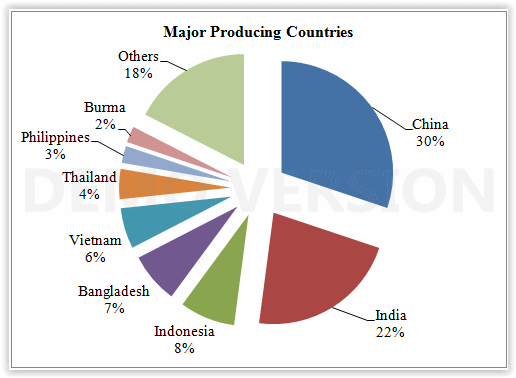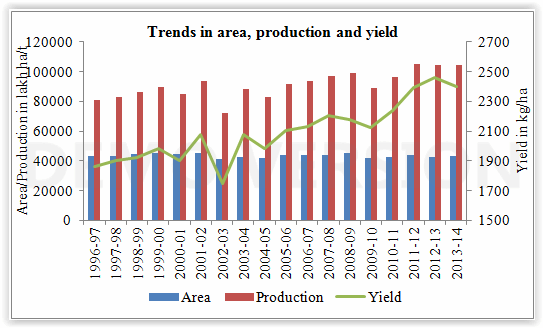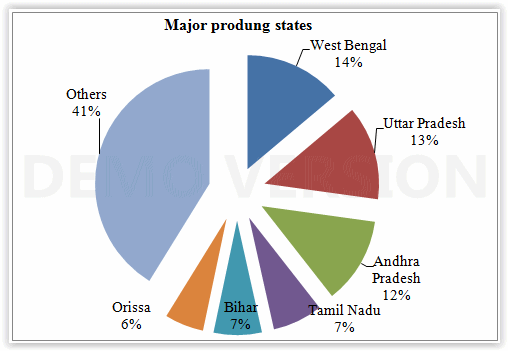|
|
Rice |
||||||||||||||||||||||||||||||||||||||||||||||||||||||||||||||||||||||||||||||||||||||||||||||||||||||||||||||||||||||||||||||||||||||||||||||||||||||||||||||||||||||||||||||||||||||||||||||||||||||||||||||||||||||||||||||||||||||||||||||||||||||||||||||||||||||||||||||||||||||||||||||||||||||||||||||||||||||||||||||||||
| 13 March 2015 03:05 PM | ||||||||||||||||||||||||||||||||||||||||||||||||||||||||||||||||||||||||||||||||||||||||||||||||||||||||||||||||||||||||||||||||||||||||||||||||||||||||||||||||||||||||||||||||||||||||||||||||||||||||||||||||||||||||||||||||||||||||||||||||||||||||||||||||||||||||||||||||||||||||||||||||||||||||||||||||||||||||||||||||||
|
Rice is a staple food for more than half of the world’s population. Rice is believed to be the first cultivated crop in the world. Asia dominates in rice production accounting for over 90% of the total world’s production in the world. It is the second largest cereal produced in the world after corn.
Historical evidence suggests that rice was originated either in southern parts of India or in the parts of India and Burma. It is also being cultivated in China since ancient times and China occupies the first place in rice production in the world. The region of India, Burma, Thailand and Cambodia is the centre for many wild rice varieties.
Economically Important Part
Rice is the seed endosperm, a rich source carbohydrates and forms the staple food for a larger section of world population particularly Asia. Un-milled rice before removing husk is called paddy.
Climate and Cultivation
Rice is cultivated in the humid area of tropics, sub-tropics and temperate regions. It has a wide adaptability and can grow up to 2000 meters above mean sea level. Rice is grown in India in different types of soils.
Rainfall or irrigation is the most important element that determines the growth and yield of rice crop. Another important element is temperature. Rice requires a fairly high temperature, ranging from 20° to 40°C and an optimum temperature of 30°C during day time and 20°C during night time. The low temperature hinders the growth of tillers.
Seasons and calendar of operations
Rice cultivation in major producing countries is well distributed across the seasons. The largest producer, China, cultivates rice in across the regions and seasons but majority of rice is harvested between August and November.
Crop calendar
In India, unlike other crops owing to its wide adaptability, rice is cultivated all over the country in almost all the seasons depending on the water availability. A broad outline of the season with respect to various states and regions that would give some idea on the supply aspects of rice are presented below.
Crop calendar India
Source: Rice Research Institute (RRI)
World Scenario
Rice is the most widely grown cereal in the world and is staple food for more than 60% of world’s population. World rice production has increased steadily but at a slow pace from about 400 million tonnes to 477 million tonnes in the past 15 years.
Source: USDA
China is the largest producer of rice contributing for over 30% of the world’s rice output. India occupies the second position accounting for about 22% followed by Indonesia with 8%, Bangladesh with 7% and Vietnam with 6% of total rice production in the world.
Table 1: Trends in global production, consumption and trade in rice (1000 tonnes)
Source: USDA
In terms of consumption also, China and India occupied the first two places contributing for about 31% and 20% respectively. Indonesia accounts for about 8.4% of world’s rise exports followed by Bangladesh for about 7.4% and Vietnam for about 4.3% to the total rice consumption in the world.
India has emerged as the major rice exporter since 2011-12 onwards replacing Thailand and accounts for about 28% of total rice exports in the world. Apart from India, exports from Vietnam also increased significantly from 2011-12 onwards, taking it to the second position with about 19% share in the total rice exports. However, Thailand regained its first position subsequently in 2013-14 and Indian rice exports are expected to moderate in 2014-15.
Domestic Scenario
India is the second largest producer as well as consumer of rice in the world. Similar to the trends in world production, rice production in India has also increased at a slow pace throughout 2000s and crossed 100 million tonnes mark in 2011-12 primarily due to rise in yields.
Table 2: Trends in balance sheet of rice (1000 tonnes)
Source: USDA
Consumption estimates of rice have also gone up steadily from about 80-85 million tonnes in the early 2000s to about 99 million tonnes in 2014-15. India maintains buffer stocks as per the norms specified to meet the domestic requirements. In view of the comfortable domestic stock position and surplus production, export of non-basmati rice was liberalised and exports have gone up to 10 million tonnes during the past few years.
Source: Ministry of Agriculture, GoI
State-wise Production
West Bengal has been the largest producing state accounting for about 14% of total rice output in the country followed by Uttar Pradesh and Andhra Pradesh competing for the second position with about 12-13% share in production. Tamil Nadu, Bihar and Orissa are the other major rice producing states contributing together for 20% of country’s rice output.
Source: Ministry of Agriculture, GoI
Major Markets
Spot markets:
Andhra Pradesh: Guntur, Ongole, Vijaywada, Machilipattanum, Nellore, Kovur, Ramchandra Puram, Khamam, Mahbubnagar, Nandyal, Siddipet, Karimnagar, Jagityal, Warangal, Nizamabad, Boddhan, Suryapet, Miryalgod, Lunettipet
West Bengal: Haldibari, Tufanganj, Alipurdwar, Siliguri, Islampur, Kandi, Bethudahari, Karmpur, Panduah, Kalna, Katwa, Burdwan, Rampurhat, Suri, Bolpur, Bishnupur, Bankura, Midnapore, Jhargram.
Uttar Pradesh: Sahajhanpur, Pilibhit, Hardoi, Ghaziabad, Sitapur, Mainpuri, Pukhrayan, Barilly, Chandauli, Powayan, Puranpur, Saharanpur, Golapokarannath, Baheri, Meerut, Dudhi, Bulandshahart, Basti, Sultanpur Kasganj, Kasipur, Rampur, Badaun, Bijnor, Moradabad, J.B. Phulnagar
Bihar: Patna City, Ara, Buxar, Mohonia, Sasaram, Siwan, Maharajganj, Muzaffarpur, Motihari, Narkatiaganj, Darbhanga, Madhubani,Sahrsa, Tribeniganj, Samstipur, Katihar, Bhagalpur, Munger, Aurangabad, Gaya, Sonbarsa, Betiah, Farbisganj,
Tamil Nadu: Thanjavar, Thiruvannamabai, Villupurm, Nagpattinum, Gimbatore, Erode, Trichitapallai, Pudukottai, Madurai, Dindigal
Futures Markets:
India – rice futures were earlier offered on domestic national multi-commodity exchanges but discontinued due to lack of volumes. International – rough rice (paddy) futures are offered on CBOT.
External Trade
Rice exports were largely confined to basmati until recently, however owing to surplus production and sufficient stocks, non-basmati rice exports have also picking up since 2011-12. Non-basmati exports have actually outpaced basmati exports and stood in the range of 4 to 7 million tonnes between 2011-12 and 2013-14 while basmati exports stood in the range of 3 to 3.7 million tonnes in the same period.
Major export destinations: Nigeria, Senegal, Benin, Cote D Ivoire and South Africa for Non-basmati rice while Iran, Saudi Arabia, UAE, Iraq, Kuwait, Yemen, UK and US for basmati rice.
Major import sources: NA
Factors influencing prices:
|
||||||||||||||||||||||||||||||||||||||||||||||||||||||||||||||||||||||||||||||||||||||||||||||||||||||||||||||||||||||||||||||||||||||||||||||||||||||||||||||||||||||||||||||||||||||||||||||||||||||||||||||||||||||||||||||||||||||||||||||||||||||||||||||||||||||||||||||||||||||||||||||||||||||||||||||||||||||||||||||||||




